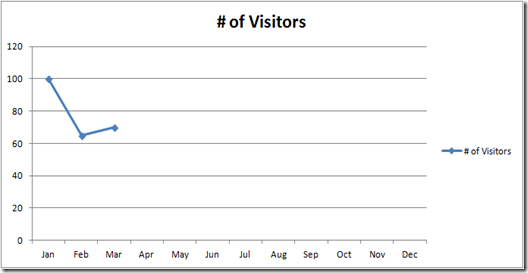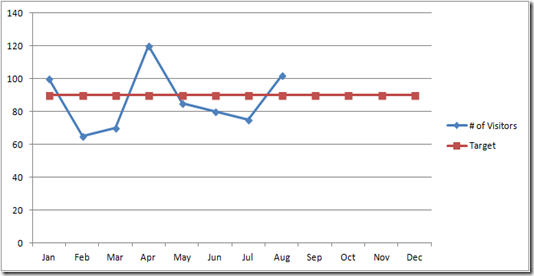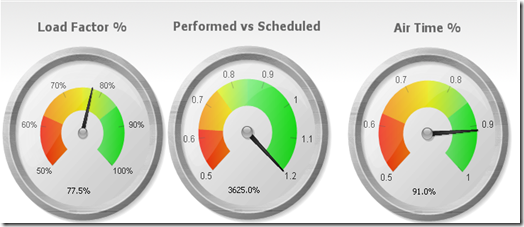Key Performance Indicators (KPI) – The ultimate guide
- March 4, 2017
- Posted by: Taha M. Mahmoud
- Category: Business Intelligence ,
To say it in a generic way, before you start work on something you should first define your goals. Then, once you begin you should always be attempting to achieve those goals. This means that from time to time you need to check how far you are from your goals and decide whether your performance concerning achieving these goals is good or bad. Here is where a KPI (key performance indicator) comes in.
Key Performance Indicators (KPIs) is a metric used to measure, monitor and indicate your performance concerning achieving your goal(s).
KPI is used mainly to measure performance and should give you an immediate impression. Using indicators, you can see whether you are meeting your target. The KPI can be any type of chart. In this article; I will explain how to define your goals and link your KPIs to them through many examples that will help you to understand the KPI creation process
Key Concepts
The Key Performance Indicators (KPIs) is used to measure your actual performance figures against your target. So, the KPI should at least have the following:
- Actual figure
- Target Figure.
- Indicator
- Display Mechanism (Chart)
- Define your goals.
- Define your metrics.
- Define your targets.
- Create your KPIs
Overview
The main purpose of a Key Performance Indicators (KPIs) is to show how close you are to your goal. However, normally you will need more than one KPI in order to indicate this. To explain KPIs in detail we will look at examples and business cases in this article. But one final note before we launch into our examples. It’s important to recognize that KPIs will be different from one business to another and from one industry to another. While you may have the same goals as another business or industry – such as increasing profits or revenue – the metrics will nevertheless be different. You may be getting lost by now, so let’s look at our examples.
Step # 1 – Define Your Goals:
Say we have a new website. Let it be websites for plastic surgeons or whatever. On our website there are many channels of income, such as advertisement, exam registration fees, products sold and so one. Now, our method is as follows. First we need to set our goals. Let’s give a simple example. Say our net profit is $10 and our goal is to make it $50 by the end of the fiscal year (don’t laugh please 🙂 !). This means our goal is to increase the net revenue of our web site by 500% in one year.
Step # 2 – Define your metrics
Now that we have a clear goal it’s time to find out how to achieve it. There are many factors that will affect our goals and we need to focus on the important ones. We call these factors ‘metrics’. A metric is usually a number that will somehow affect your goal – such as a number of sold products. Let’s define our metrics here.
Net profit = net income minus (-) the net cost
Net income = [number of sold products multiplied by (*) the unit price] – product income
Plus (+) [number of visitors multiplied by (*) ad revenue per view]
Plus (+) [number of adverts clicks multiplied by (*) how much you earn per advert click]
Plus (+) [number of scheduled exams multiplied by (*) the exam fee] – exam income
Net cost = fixed monthly site maintenance
Plus (+) product processing cost
Plus (+) exam setup
Plus (+) …….
Now, as you can see, there are some variable metrics and some static ones. For example, the ‘number of visitors’ is a dynamic variable metric and the ‘monthly site maintenance’ fee is a static one. You should concentrate on the dynamic variable metrics in your KPIs. Now I will use the ‘number of visitors’ as a metric in my first KPI. But is it enough to simply have a metric? Of course not. You need somehow to link this to your goal (achieving $50 by the end of the year). In order to make it more clear, check the trend graph below:
 Figure # 1 : Number of visitors trend
Figure # 1 : Number of visitors trend
Step # 3 – Define your target:
As you can see, the graph shows you the number of visitors per month. However, this is not enough information to know whether those figures are good or bad. Does the information that I had 100 visitors in January, 65 visitors in February, and 70 visitors in March allow us to draw the conclusion whether or not I will be able to achieve my goal by the end of year? As you can see, metrics are just plain numbers and here all that we can indicate is the trend. However, by linking your metric to time you can get an idea whether or not your number of visitors are increasing or decreeing over time. And as we already saw, in accordance with our goal we need to increase our visitors in general in order to get more advertisement income. Up until now what we have is just a trend metric and there is something missing.
Let’s say that in order to achieve $50 by the end of the year our strategy is to focus on ad profits. Normally we will make $10 at the end of the year, but now we intend to increase this by way of increasing the average number of visitors per month, while leaving everything else the same. Let’s say the old average number of visitors of my site was 60 per month. This means that if I were to get 60 visitors per month, and everything else remained the same, then I should make a $10 profit by the end of the year. We now need to calculate the new required average number of visitors (the target), while assuming that none of the other factors will change, in order for us to hit our goal of making $50 at the end of the year. Let’s say that the target here would be 90 visitors per month on average, which would in turn achieve our goal. Now the graph should look like this:
 Figure 2 – Number of visitors against target
Figure 2 – Number of visitors against target
Step # 4 – Build your Key Performance Indicators (KPIs):
Congratulations, we now have our first KPI. As you can see, after we added our monthly target required to be met in order to achieve our goal, we then indicated our performance, month by month, to track our progress. We can easily see that we performed well in January, April and August. We nearly achieved our target in May and performed badly in the remaining months. So, let’s recap what we explained so far.
How to define your KPIs:
Define a goal: first you need to define your goals or set of goals. Your goals should define both what you want to achieve, and when you want to achieve this.
Define a metric: the next step is to define your metric. A metric is a number that will affect your goal.
Define a target: next you need to specify how your metric should behave in order to achieve your goal. The target is the behavior required to achieve the goal.
Build your KPI: Key Performance Indicators (KPIs) will show how your metric will behave against the pre-set target and will indicate your performance against your target required to achieve your goal.
Visual elements used to present KPIs (charts)
In our previous example we had one measure (the number of visitors) and one dimension (time). Therefore we chose to use a line chart since this is the best visual element to show a time trend.
Let’s now detail all the possible combinations:
Single value KPI: If you have one metric and there is no dimension
The best way to present single value Key Performance Indicators (KPIs) is to use one of the following visual element components:
- Dial
- Speedometer
- Gauge
 Figure # 3 – Single Value KPI
Figure # 3 – Single Value KPI
Multivalued KPI: If you have one or more metrics and one or more dimensions
Case # 1: One metric and one dimension:
This case will depend on the nature of your dimension. If the dimension is a time dimension then a line chart is preferred, as this is the best to show trends. If your dimension is cyclical, such as the 12 month cycle, you may use a radar chart. If you have a dimension such as a region or a customer segment, then you may use a pie chart or bar chart.
Case # 2: Two metrics and one dimension:
In this case you should use a combined chart, which is a combination of a line chart and bar chart. The bars will represent one metric and the line will represent the second one, while your dimension will be shown in the X axis.
Case # 3: One metric and two dimensions:
Here you may use one of the following:
- Bar chart
- Stacked bar chart
I will make a special post on types of charts (visual elements) and the suitable use of each one.
Key performance indicator (KPI) types:
Internal:
- Measure internal performance
- Not shared with anything outside the unit
- The connection to the enterprise business goals in not clear and not strongly mapped to the enterprise goals
- Important for tracking productivity and performance
- Examples:
- Response time
- Delivery rate
External:
- Measure the real metrics which are directly related to the main goals of the enterprise
- Shared and broken down into smaller KPIs, and has been measured on smaller units and departments as well
Final Notes
- Score Cards: Sometimes you may need to group more than one KPI in order to measure your goal. When you do this, this is what we call a score card. If all Key Performance Indicators (KPIs) in the score card are equal in weight and equally contribute towards achieving the goal, then this is a balanced score card. If KPIs have different weights, then this is what we call an unbalanced score card.
- Key Risk Indicator: KRI is the same as KPI, with the key difference that instead of measuring or indicating performance it is indicating risk.
- Indicators: You can use various visual effects to indicate a good or bad performance. A traffic light, with the three colors, is the most well known and famous indicator. Other indicators include icons and font size.
- Dashboard: is a container for some relative Indicators, KPIs, KRI, score cards, reports and charts.
Author: tahama_2000
2 Comments
Comments are closed.


Taha, When and where we can use KPI in Project , i know that different between organization to organization (initiating,planing,executing,monitor and controlling,closing ),,,,,,,,,,,,
It is as per the project manager. He can establish a set of KPIs to measure each and very process of the project management cycle. As per PMI, there are many KPIs already defined to measure project performance against schedule and budget (Earning Value Analysis); we will have a complete article to cover this section. You can also as a project manager have many other KPIs to track the performance of your project considering other aspects like quality, risk, procurement, …etc. The method described here is very generic and can work with almost anything 🙂